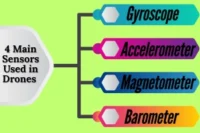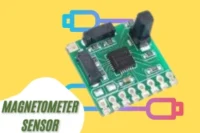The Role of Gyroscope Sensors in Smooth Drone Flights
Published: 28 Jul 2025
How does your drone know when it’s tilting or spinning too much? The answer lies in the gyroscope sensor in drone technology. This little tool keeps track of the drone’s movement, like rotation and direction. It sends signals to the flight controller, which makes tiny adjustments to keep the drone stable. Think of it like your inner ear that helps you balance, it works behind the scenes but makes a big impact. If you have ever flown a drone that stayed level while moving fast, you have already seen the gyroscope sensor in action.
What Is a Gyroscope Sensor
A gyroscope sensor is a tiny device inside your drone that helps it stay balanced. It works by detecting how the drone rotates or tilts in the air. This includes movements like rolling to the side, tilting forward or backward, or spinning in place—known as pitch, roll, and yaw. Think of it like the way your phone screen rotates when you turn it sideways—that’s a gyroscope in action. Or better yet, imagine your inner ear helping you stay upright when you spin around. That’s exactly what the gyroscope does for your drone, it keeps it steady and aware of how it’s moving.
How Does Gyroscope Sensor Work in a Drone
The gyroscope sensor plays a big role in helping your drone fly smoothly. It works behind the scenes to detect movement, send signals, and make quick adjustments.
Detects Movement Instantly : The gyroscope watches for changes in the drone’s position. If the drone tilts, spins, or rolls—even slightly the sensor picks it up right away.
Talks to the Flight Controller : Once movement is detected, the sensor sends that information to the drone’s flight controller. This brain decides what changes need to happen to fix the tilt or spin.
Makes Real-Time Adjustments : The flight controller then tells the motors what to do. It might speed up one motor or slow down another to balance the drone again.
Simple Example: Imagine your drone tips to the left. The flight controller notices this and quickly boosts power to the left-side motors to bring it back to level flight.
Importance of gyroscope sensor in drone
The gyroscope sensor does more than just detect movement—it helps your drone fly safely and smoothly. Without it, flying would be shaky, risky, and hard to control. Here’s why this sensor is so important:
Keeps the Drone Stable : The gyroscope helps the drone stay level while flying. It stops the drone from wobbling, tipping, or spinning out of control, especially when you’re making turns or flying in tricky conditions.
Helps in Hovering : Want your drone to stay still in the air? The gyroscope makes that possible. It keeps the drone balanced so it doesn’t drift or slide around while hovering.
Improves Camera Work : For those using drones for photos or videos, this sensor is a must. It helps reduce shaking, allowing your camera to capture clean, stable footage, even during movement.
Supports Safer Flying :The gyroscope plays a big role in safe takeoffs and landings. It also helps the drone stay balanced in windy weather, making your flight smoother and reducing the chances of crashes.
Gyroscope vs. Accelerometer
Drones need to understand both how they spin and how they move in a straight line. That’s why they use two important sensors: the gyroscope and the accelerometer.
| Gyroscope |
|---|
|
Measures how the drone rotates or tilts (pitch, roll, yaw) Helps the drone stay balanced during turns or spins. Used to detect and control turning motions. |
| Accelerometer |
|---|
|
Measures how fast the drone moves in a straight line (up, down, forward, backward) Helps the drone know if it’s rising, falling, or sliding sideways. Used to track acceleration or sudden stops. |
Where Gyroscope Sensor Find It in the Drone
You won’t see the gyroscope sensor when you look at a drone, but it’s there, working hard behind the scenes. It’s built into a small unit called the IMU, or Inertial Measurement Unit, which also includes the accelerometer. This unit is tucked inside the drone’s main electronics, usually near the flight controller. You don’t need to maintain it or adjust anything, it runs automatically every time your drone flies. Whether you are using a small hobby drone or a professional GPS drone, the gyroscope sensor is always there, helping your drone stay stable and fly safely.
Conclusion
We have covered the gyroscope sensor in the drone in detail. If you are just starting out with drones, I highly recommend choosing a model that has a built-in gyroscope and accelerometer. It’ll make flying easier, smoother, and a lot more fun. Ready to level up your drone skills? Explore your drone’s settings and see the gyro in action—then go out and enjoy your next flight with confidence.
FAQs
No, they are not the same. The gyroscope is just one part of the system, it detects motion. The flight controller uses the gyro’s data to decide how the drone should react.
Yes, almost all drones big or small have a gyroscope sensor. It’s a basic part of modern drone design. Even toy drones use one to stay balanced.
Yes, it can. If the gyroscope isn’t working properly, your drone may wobble, tilt, or crash. Always check your drone if it behaves oddly during flight.
No, it doesn’t need maintenance. It’s a sealed, built-in component. Just make sure your drone’s firmware is updated—that keeps all sensors working properly.





